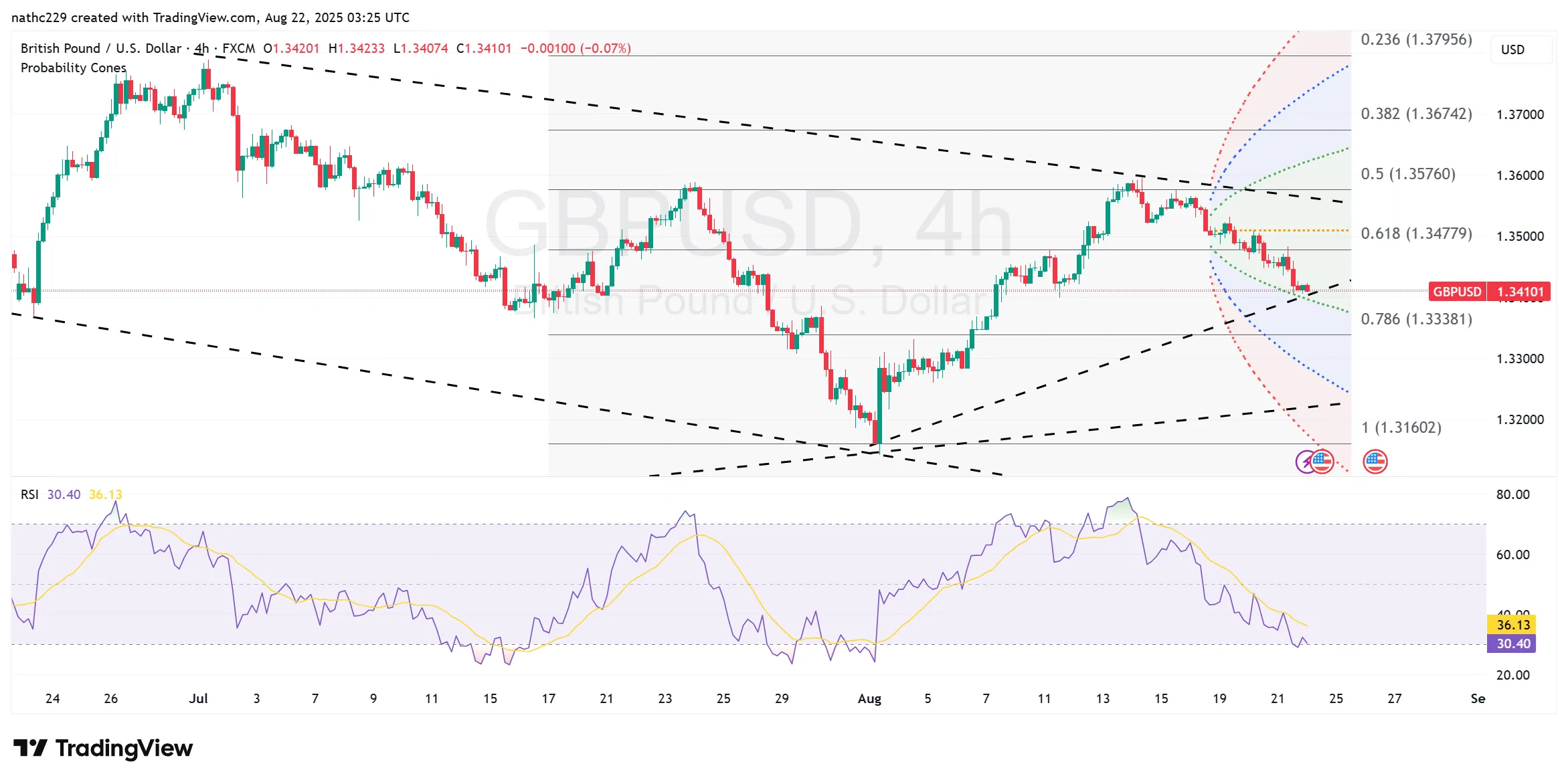
GBP/USD – Sterling Under Heavy Pressure; Crucial Support Levels in Play Ahead of Powell
GBP/USD is exhibiting pronounced bearish sentiment, having retreated significantly amid a resurgence of the U.S. dollar driven by shifting Fed rate expectations. Thursday’s trading saw the pair declining 0.3%, reaching intraday lows around 1.3407 and currently hovering near 1.3420. This notable bearish momentum primarily stems from rising U.S. Treasury yields ahead of the highly anticipated Jackson Hole speech by Federal Reserve Chair Jerome Powell, as markets increasingly price in a less-dovish rate trajectory than previously expected.
Fundamentally, market sentiment has distinctly shifted towards caution. Recent U.S. economic data, particularly stronger-than-anticipated producer prices (PPI), has reignited concerns about persistent inflationary pressures. Consequently, short-term interest rate futures have substantially adjusted, now pricing in less aggressive Fed easing expectations. Specifically, the implied probability of a September Fed rate cut has declined below 80%, and the total anticipated rate cuts by December have diminished to approximately 51 basis points, down notably from earlier August estimates around mid-60s.
This less dovish Fed narrative directly contrasts with escalating UK fiscal worries, amplified by recent increases in gilt yields. Rising yields reflect mounting market concerns over the UK’s public finances and fiscal stability, exerting additional downward pressure on sterling sentiment. Although UK composite PMI data provided brief intraday support, optimism was quickly overshadowed by broader fundamental fears, including forthcoming UK consumer confidence data forecast to deteriorate further.
From a technical perspective, GBP/USD is precariously testing the pivotal 100-day moving average (DMA), positioned around 1.3410. A decisive daily close below this critical technical barrier would markedly intensify bearish momentum, targeting deeper support levels. Subsequent technical support is clearly defined by the August 7 low at 1.3346, followed by the critical 50% Fibonacci retracement of the broader move from 1.2712 to 1.3787, located at 1.3250. Should selling pressure persist and drive GBP/USD below the psychologically significant Fibonacci support at 1.3250, it would expose substantial downside risk toward the next major target at the August 1 low near 1.3142, and potentially the 200-day moving average situated near the 1.3000 threshold.
Technical indicators further underscore bearish pressures. Daily RSI is steadily declining below the neutral 50 level, indicating strong downside momentum without yet reaching oversold extremes, suggesting ample scope for further downside. The MACD histogram continues trending negatively, reinforcing the prevailing bearish bias.
On the upside, immediate resistance stands firmly at Thursday’s intraday high of 1.3483, followed by the daily Ichimoku cloud top at 1.3543. A more substantial barrier resides at the upper boundary of the descending 30-day Bollinger Band, currently positioned around 1.3621. Bulls would need a decisive reclaiming of these resistance levels to alleviate immediate bearish pressures.
In summary, GBP/USD faces significant near-term bearish risks, heightened by rising U.S. yields, diminished Fed easing expectations, and escalating UK fiscal concerns. Traders must remain vigilant, closely monitoring critical support levels, notably the 100-DMA at 1.3410 and the crucial 1.3250 Fibonacci retracement. Fed Chair Powell’s Jackson Hole commentary will be pivotal, potentially intensifying downside momentum if a less-dovish policy stance is confirmed.
